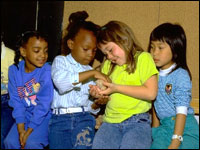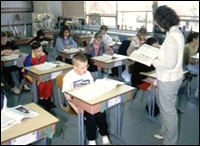Attention, parents: Now that you’ve seen your kids’ first report cards of the year, it’s time for a little homework of your own. No doubt you’re doing the best you can to ensure your little ones’ eventual membership in Mensa — promoting stimulating dinner conversation, reading a chapter together each night, maybe even playing Mozart during bath time. But wait — there’s more. You’ll find your next assignment in the pages of Colleen Moore’s Silent Scourge: Children, Pollution, and Why Scientists Disagree.
You probably already know that lead is not an appropriate component of any cerebral calisthenics program. But nor is it the only pollutant that can stunt intellectual development. In Silent Scourge, Moore, a developmental psychologist, reviews the case against lead and five additional types of pollutants — mercury, PCBs, pesticides, noise, and radioactive and chemical wastes.
With the possible exception of noise, most people recognize these pollutants as harmful and wouldn’t actively incorporate them into K-12 curriculums or meal plans. But that doesn’t mean we’ve got the necessary information — or power — to protect kids from them. Each of these pollutants has been the object of protracted debate, the kind of media-moderated, he-said/she-said dispute that frequently leaves us more worn down than wised up. Moore cuts through the confusion, using lay language to explain the dangers each pollutant poses to child development, including intellectual function, behavior, emotional state, and overall physical and psychological well-being.

No kidding: Pollution is bad for
young’uns.
Her conclusion: Children exposed to these pollutants — which is to say, all children, to one degree or another — experience consequences both subtle and profound. “These types of pollution are usually silent and insidious,” she writes. “The effects … are revealed by carefully constructed psychological assessments of memory, attention, learning, motor skills, intelligence, personality, emotion, and other characteristics.”
Moore is painstakingly fair, which, as any reality-TV producer can tell you, eliminates much of the potential for crowd-pleasing drama. She’s tried hard to be evenhanded in her explication of the science. Perhaps most important, she explains one of the great mysteries of science and public-policy debate: how “scientists can disagree about the scientific evidence without being dishonest.”
In answering that question, Moore doesn’t point her finger at outright corruption, corporate influence, or political manipulation, though these certainly can be complicating factors. Rather, she reports, scientists can disagree without being dishonest simply by “applying different decision standards.”

Does the science add up?
Decision standards determine how science gets used in the policy equation. This takes us back to lead again, and to 1926, when then-Surgeon General Hugh Cummings had to decide whether to allow the use of lead additives in gasoline. Using an early version of one decision standard, the precautionary principle, public-health advocates argued that the lead additive should be banned until it was shown to be safe. Industry countered with the so-called Kehoe Paradigm: “Tetraethyl lead should be allowed unless and until it is shown to be a health hazard … because there are benefits of its use” and uncertainty about effects. Industry won, with the result that lead wasn’t removed from gasoline until the 1970s. But perhaps the more important outcome was that the burden of proof in U.S. environmental policy was placed squarely on the polluted, not the polluter.
Nearly 80 years later, the rap sheet on lead is fairly complete, and quite damning. Even as Silent Scourge was hitting bookstores, a new study came out refuting the long-held belief that children can handle small amounts of lead. As Richard Canfield of Cornell University told the Los Angeles Times, “There is no safe level of exposure.”
So what’s the verdict on these other “silent scourges”? Forget about verdicts, Moore says; we’re still awaiting evidence: “Where are we now in the study of pesticides and children’s behavioral development? Basically we are in the 1940s. … I have been unable to find any studies that follow up child pesticide poisoning victims to see how they perform in school later. There has not even been good research to see if there is a link between current exposures to pesticides and neurobehavioral functioning in children.”
Moore believes that the lack of research has to do with a widespread belief that low-level exposure to pesticides is safe. Environmental-justice issues may also be at work: Those children most likely to be exposed to pesticides are poor and minority kids living in inner cities or agricultural areas.
Sound Effects
Perhaps the most ear-opening science in Moore’s book deals with one of the most common pollutants in the educational system: noise. Thousands of U.S. schools — many of them in lower income areas — are built near roads or rails, or in the flight paths of low-flying planes. According to national survey data, at any given time, one in seven children in a classroom has a temporary hearing loss of 16 decibels or greater, most likely from a head cold or ear infection. If any additional factor degrades the sound environment, those children simply can’t hear what’s going on.

Can you hear me now?
Most people know that particularly loud noises can damage hearing, but continuous background noise can also cause harm. The best research so far on this topic was done in 1973 and concerned a high-rise public housing project built over I-95 in Manhattan. The researchers compared the reading levels of children who lived on the bottom floors, close to traffic noise, with those who lived higher up, where the noise was not as loud. All the children went to the same schools, and the income restrictions for eligibility to live in the project helped control for economic and educational backgrounds (which have by far the most significant effect on children’s scholastic achievement). For those children who had lived in the apartments for at least four years, approximately 20 percent of the difference in reading scores could be predicted simply from their floor number.
Noise affects not just cognitive performance, like reading ability, but also mental health and such anxiety responses as annoyance, blood pressure, and stress hormone secretion. “Hearing other people talk is critical to children’s early language development,” Moore explains. “Memory and performance can be impaired because of the extra effort required to decipher speech [when there is significant background noise]. Mood can also become more negative, and the person feels tired or stressed.”
A little noise may seem like a minimal burden, but the effects of noise pollution “can cascade into poor overall academic performance and lack of motivation in school,” Moore writes. “Poor reading is a negative factor that can lead to other academic and social problems, so anything that affects children’s early reading needs careful consideration.” That is, a little downward pressure on children’s early potential can snowball into serious, lifelong consequences. And as with pesticides, the consequences of noise pollution are borne unequally, with poor and minority children more likely to be exposed to continuous background noise. What’s more, such children are also more likely to be affected by lead and other pollutants, a true double (or triple, or quadruple) whammy.
School Daze
How, then, should we go about protecting kids from these common hazards? One of Moore’s main points is that “we do not need a ‘body count’ of deaths or cancer cases in order to conclude that a category of pollution has serious developmental effects.” Moore argues that developmental psychology could help us escape this body-count paradigm for assessing the impacts of pollutants — and thus ultimately help us better regulate them.

It’s a jungle (gym) out
there.
Photo: EPA.
Currently, much of our regulation of chemicals is based on two kinds of tests. Screening tests assess whether a substance will, under laboratory conditions, cause tumors or birth defects. Epidemiological tests look backwards, in a complicated and often futile attempt to demonstrate a link between cause and effect, exposure and illness. But these tests fail children on three counts. First, they focus on catastrophic impacts, while developmental impacts are more often subtle and incremental. Second, they’re more concerned with the response to high doses, despite considerable evidence that developmental harm can occur at low doses. And third, they don’t look at the effects of exposure to more than one pollutant, which is almost invariably what happens in real life.
Consider mercury, a potent neurotoxin. (And a recent headline-maker, after the Bush administration proposed regulatory changes that could stymie efforts to reduce mercury pollution.) “The question now is not whether mercury is toxic, but how much exposure is too much for whom,” writes Moore. “This is where the controversy occurs both among researchers and in government regulations.” The same could be said of PCBs: Scientists are still arguing over whether PCBs cause cancer. If we used developmental benchmarks instead, Moore says, we would see devastating and irrefutable impacts on child development at doses where PCBs only ambiguously suggest cancer.
In other words, science will only answer the questions we ask of it — and therefore it can never be a proxy for our own morals. Moore has performed a huge public service with this book by unraveling the tangled skein of contested findings and revealing the value differences at the core of scientific debate. And her ultimate argument is difficult to take issue with: “Protecting children from pollution is plainly an ethical choice.”
It’s not a good-time read, but Silent Scourge could become an important tool for educating the public about paradigms for understanding the links between pollution and health, arming them with questions we should all be asking. Back to school, everybody.



